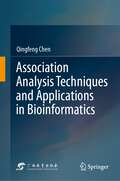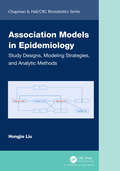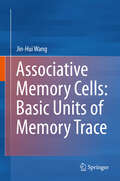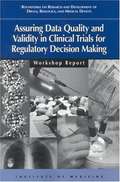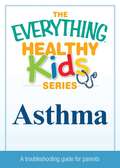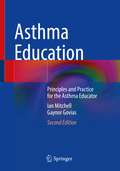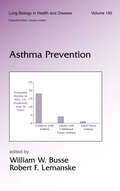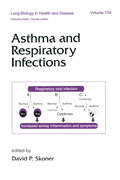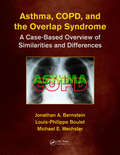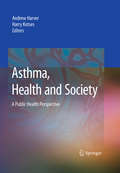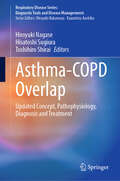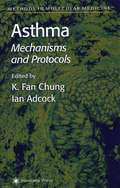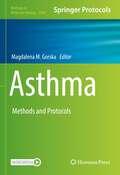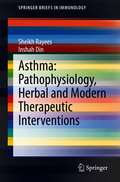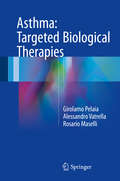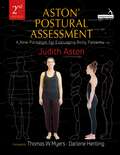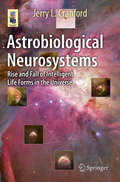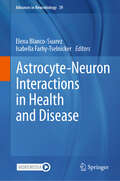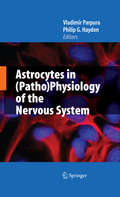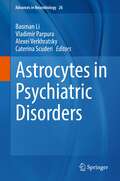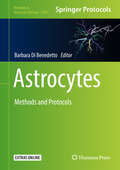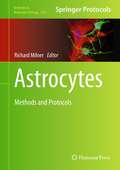- Table View
- List View
Association Analysis Techniques and Applications in Bioinformatics
by Qingfeng ChenAdvances in experimental technologies have given rise to tremendous amounts of biology data. This not only offers valuable sources of data to help understand biological evolution and functional mechanisms, but also poses challenges for accurate and effective data analysis. This book offers an essential introduction to the theoretical and practical aspects of association analysis, including data pre-processing, data mining methods/algorithms, and tools that are widely applied for computational biology. It covers significant recent advances in the field, both foundational and application-oriented, helping readers understand the basic principles and emerging techniques used to discover interesting association patterns in diverse and heterogeneous biology data, such as structure-function correlations, and complex networks with gene/protein regulation. The main results and approaches are described in an easy-to-follow way and accompanied by sufficientreferences and suggestions for future research. This carefully edited monograph is intended to provide investigators in the fields of data mining, machine learning, artificial intelligence, and bioinformatics with a profound guide to the role of association analysis in computational biology. It is also very useful as a general source of information on association analysis, and as an overall accompanying course book and self-study material for graduate students and researchers in both computer science and bioinformatics.
Association Models in Epidemiology: Study Designs, Modeling Strategies, and Analytic Methods (Chapman & Hall/CRC Biostatistics Series)
by Hongjie LiuAssociation Models in Epidemiology: Study Designs, Modeling Strategies, and Analytic Methods is written by an epidemiologist for graduate students, researchers, and practitioners who will use regression techniques to analyze data. It focuses on association models rather than prediction models. The book targets students and working professionals who lack bona fide modeling experts but are committed to conducting appropriate regression analyses and generating valid findings from their projects. This book aims to offer detailed strategies to guide them in modeling epidemiologic data.Features Custom-Tailored Models: Discover association models specifically designed for epidemiologic study designs. Epidemiologic Principles in Action: Learn how to apply and translate epidemiologic principles into regression modeling techniques. Model Specification Guidance: Get expert guidance on model specifications to estimate exposure-outcome associations, accurately controlling for confounding bias. Accessible Language: Explore regression intricacies in user-friendly language, accompanied by real-world examples that make learning easier. Step-by-Step Approach: Follow a straightforward step-by-step approach to master strategies and procedures for analysis. Rich in Examples: Benefit from 120 examples, 77 figures, 86 tables, and 174 SAS® outputs with annotations to enhance your understanding. Book website located here. Crafted for two primary audiences, this text benefits graduate epidemiology students seeking to understand how epidemiologic principles inform modeling analyses and public health professionals conducting independent analyses in their work. Therefore, this book serves as a textbook in the classroom and as a reference book in the workplace. A wealth of supporting material is available for download from the book’s CRC Press webpage. Upon completing this text, readers should gain confidence in accurately estimating associations between risk factors and outcomes, controlling confounding bias, and assessing effect modification.
Associative Memory Cells: Basic Units of Memory Trace
by Jin-Hui WangThis book focuses on associative memory cells and their working principles, which can be applied to associative memories and memory-relevant cognitions. Providing comprehensive diagrams, it presents the author's personal perspectives on pathology and therapeutic strategies for memory deficits in patients suffering from neurological diseases and psychiatric disorders. Associative learning is a common approach to acquire multiple associated signals, including knowledge, experiences and skills from natural environments or social interaction. The identification of the cellular and molecular mechanisms underlying associative memory is important in furthering our understanding of the principles of memory formation and memory-relevant behaviors as well as in developing therapeutic strategies that enhance memory capacity in healthy individuals and improve memory deficit in patients suffering from neurological disease and psychiatric disorders. Although a series of hypotheses about neural substrates for associative memory has been proposed, numerous questions still need to be addressed, especially the basic units and their working principle in engrams and circuits specific for various memory patterns. This book summarizes the developments concerning associative memory cells reported in current and past literature, providing a valuable overview of the field for neuroscientists, psychologists and students.
Assuring Data Quality and Validity in Clinical Trials for Regulatory Decision Making: Workshop Report
by Institute of MedicineA report Assuring Data Quality and Validity in Clinical Trials for Regulatory Decision Making
Asthma
by Adams MediaFor parents, few experiences provoke more anxiety than the thought of a sick child. The Everything® Healthy Living Series is here to help. These concise, thoughtful guides offer the expert advice and the latest medical information you need to understand your child’s ailments and provide the best possible care. Childhood illnesses are inevitable; the way you approach treatment is not.Inside you’ll find expert advice on recognizing asthma symptoms, seeking treatment, managing attacks, and identifying triggers. An asthma diagnosis can be frightening, but with proper guidance your child can lead a healthy and happy life.
Asthma Education: Principles and Practice for the Asthma Educator
by Ian Mitchell Gaynor GoviasThis book comprehensively presents all the necessary information health professionals need to become Certified Asthma Educators. Competent asthma educators must possess a number of skills: they must have appropriate and sound medical and pharmaceutical knowledge; be proficient and effective educators who can influence their patients’ behaviors for the better; and, finally, they need the administrative and organizational skills needed to set up and run efficient clinics at their places of work. The book is divided into three sections to meet those needs: Asthma: The Fundamentals; The Role of Education; and, The Effective Asthma Educator. The first section covers clinical knowledge of asthma, with chapters including lung structure and function, clinical presentation of asthma, and environmental issues in asthma management. The second section delves into the role of educating patients and teaches readers how to best do that with an integrated approach between physician, educator, and patient. The third section looks further into educating techniques with a view of the learning process, considerations for instruction locations, and the role the educator plays overall. The final chapter in the book presents example cases for readers to assess the knowledge they have learned throughout. This second edition serves as both textbook and study guide for certification as well as a long-term reference publication. It has been fully updated from the previous edition with the latest treatment guidelines, medications, and disease monitoring methods. This is an ideal guide for asthma educators, those seeking NAECB certification, and any health professional involved with individuals who have asthma.
Asthma Prevention (Lung Biology in Health and Disease)
by William W. Busse Robert F. Lemanske Jr.Collecting research from leading specialists in the field, this reference contains the latest studies on the genetic and environmental origins, pathogenesis, and immunology of asthma-promoting new research pathways for the development of new therapeutic interventions in the prevention of this common disease.
Asthma and Respiratory Infections (Lung Biology in Health and Disease)
by David P. SkonerPerforming a thorough and detailed study of one of the most common yet less accurately understood causes of human illness, this all-inclusive reference examines the epidemiology, pathophysiology, and future treatment options for asthma and respiratory infections. Contains up-to-date results from clinical trials of antiviral agents that expl
Asthma in the Workplace
by Jean-Luc Malo David I. Bernstein Susan M. Tarlo Olivier VandenplasAsthma can be caused and aggravated by occupational factors in working adults. Agents that are responsible for occupational asthma are either sensitizers or irritants. Prevention is important to reduce the impact of the disease. This new edition of Asthma in the Workplace focuses on recent developments that are reflected by an impressive addition to the scientific literature. This fifth edition retains key elements that have made the success of previous editions: worldwide contributors, variety of topics covered, presentation of key aspects using workplace scenarios and case histories. This new comprehensive edition is intended to be of interest for health professionals, researchers, students, practitioners and various professionals involved in the assessment and management of workers exposed to occupational factors that may cause or exacerbate asthma. Key Features Comprehensive coverage of all aspects of work-related asthma, including historical aspects, epidemiology and risk factors, mechanisms and genetics, other types of work-related asthma conditions and variants, hypersensitivity pneumonitis, occupational urticaria and dermatitis Assessment of the worker and workplace along with management of the worker, prevention and medicolegal aspects Detailed information about specific agents, including a variety of high-molecular-weight and low-molecular-weight agents
Asthma, Allergic and Immunologic Diseases During Pregnancy: A Guide to Management
by Jennifer A. Namazy Michael SchatzWith insight and research from world-renowned experts, this book provides specific approaches to diagnosis and treatment, addressing pharmacologic and non-pharmacologic management. Specific conditions examined include asthma, rhinitis and sinusitis, anaphylaxis, atopic and contact dermatitis, urticaria and angioedema, hereditary angioedema, drug allergies, and primary immune deficiency. An overview of obstetric management of the high risk asthmatic and allergic patient is provided, and the book concludes with a discussion of the prevention of asthma and allergic diseases during childhood.
Asthma, COPD, and Overlap: A Case-Based Overview of Similarities and Differences
by Jonathan A. Bernstein Louis-Philippe Boulet Michael E. Wechsler, MD,MMScUsing illustrative case examples, this book thoroughly reviews similarities and differences between asthma, chronic obstructive pulmonary disease (COPD) and the overlap syndrome. It is important to highlight the distinctions because these commonly encountered conditions in respiratory and primary care share many similarities but have important differences often mistaken for each other. This can have serious implications for treatment, particularly as new treatments are targeted at specific phenotypes of the diseases. This practical guide shows how to distinguish between the diseases on a pathological and clinical basis so that appropriate management and treatment may be pursued.
Asthma, Health and Society: A Public Health Perspective
by Andrew Harver Harry KotsesAsthma, Health, and Society A Public Health Perspective Edited by Andrew Harver, University of North Carolina at Charlotte, Charlotte Harry Kotses, Ohio University, Athens Asthma, Health, and Society is a comprehensive, current resource on this complex disease--its scope, human costs, and management--from a combined social ecology/public health perspective. This important and unique book proposes a concerted, multifaceted response and sets out the foundation for shaping this response, comprising individual and large-scale assessment, education, advocacy, and multiple forms of intervention. In clear, authoritative detail enhanced by figures, graphs, and references, contributors explain where universal standards need to be set, alliances need to be built (such as among agencies and institutions in a community), and what is currently known about: Pathophysiology, epidemiology, and social impact of asthma. Genetic and environmental factors; protective factors and risk markers. Effects in women, minorities, children, teens, and elders. Medical management, self-management, and home monitoring. Evidence-based interventions at the family, school, and community levels. Screening guidelines, compliance issues, and more. In the absence of a cure or clear-cut causes, Asthma, Health, and Society offers the most robust compilation of practical knowledge on its subject to benefit the range of public health and asthma professionals, researchers, teachers, and students
Asthma-COPD Overlap: Updated Concept, Pathophysiology, Diagnosis and Treatment (Respiratory Disease Series: Diagnostic Tools and Disease Managements)
by Hiroyuki Nagase Hisatoshi Sugiura Toshihiro ShiraiThis book elucidates the diagnostic criteria and concept of asthma-COPD overlap (ACO) and provides the latest information on its epidemiology, pathophysiology, diagnostic criteria, and treatment options. It discusses the controversy-causing findings of prognosis of ACO, the novel molecular mechanism including nitrosative stress, radiological or physiological features, findings by research that used HRCT or forced oscillation technique. In addition to a recent animal model of ACO, the role of each biomarker, the latest results of ICS/LAMA/LABA combination inhalers or biologics is also debated. Asthma COPD Overlap -Updated Concept, Pathophysiology, Diagnosis, and Treatment is addressed not only to beginners, but also to physicians engaged in clinical practice, supervisors, and many basic researchers. Covering every aspect of ACO, it serves readers to improve diagnosis or treatment for patients with ACO.
Asthma: Clinician's Desk Reference (Clinician's Desk Reference Series)
by J Douglas Kurtis ElwardAs the series title implies each Clinician's Desk Reference is a practical resource and a daily aid for physicians in the hospital setting and in primary care.Asthma is one of the most important chronic disorders in the developed world. Evidence from around the world shows the prevalence of asthma has increased considerably since 1975, and now affe
Asthma: Mechanisms And Protocols (Methods in Molecular Medicine #44)
by K. Fan Chung Ian AdcockK. Fan Chung and Ian Adcock bring together the first collection of laboratory methods for studying the molecular and cellular mechanisms of asthma. Leading experts describe highly effective methods for obtaining cells from asthmatic airways, analyzing gene and protein expression in these clinical samples, and using molecular and cellular tools for studying cytokine expression and release in this disease. There are also cutting-edge techniques for studying asthma-related genes and genetic polymorphisms, and for understanding the effects of asthma treatment. User-friendly and state-of-the-art, Asthma: Mechanisms and Protocols provides all asthma researchers-whether novice or experienced, whether in experimental or clinical research-with a first-class collection of readily reproducible pharmacological, cellular, molecular, biochemical, and genetic methods for elucidating not only the mechanisms of the disease itself, but also of the drugs for asthma's treatment.
Asthma: Methods and Protocols (Methods in Molecular Biology #2506)
by Magdalena M. GorskaThis volume details a collection of laboratory protocols to study asthma in mice and humans. Chapters cover animal models of asthma, methods to measure asthma-related molecules, protocols to detect, isolate, culture and stimulate cells that contribute to asthma in mice and humans, methods to deplete these cells in vivo and study responses of intact airway tissues ex vivo. Written in the format of the highly successful Methods in Molecular Biology series, each chapter includes an introduction to the topic, lists necessary materials and reagents, includes tips on troubleshooting and known pitfalls, and step-by-step, readily reproducible protocols. Authoritative and cutting-edge, Asthma: Methods and Protocols aims to be a foundation for future studies and to be a source of inspiration for new investigations in the field.
Asthma: Pathophysiology, Herbal and Modern Therapeutic Interventions (SpringerBriefs in Immunology)
by Sheikh Rayees Inshah DinAsthma is a chronic airway disease affecting over 300 million people worldwide with an expected increase of an additional 100 million by 2025. Past decade has observed a notable increase in asthma prevalence on both national and global levels with highest rates observed in western countries (about 30%). Over the past 40 years, a drastic increase in global prevalence, morbidity, mortality, and economic burden have been observed due to asthma especially in children. The rising numbers of hospital admissions for asthma, especially young children, reflect an increase in severe asthma, poverty and lack of proper disease management. Worldwide, approximately 180,000 deaths annually are caused due to this condition. The financial burden on a single asthma patient per year in different western countries ranges from US$300–1,300.Asthma is an intricate respiratory disorder with differences in its severity, natural history and hence treatment response. These differences in intensities of various presentations such as bronchial hyper-responsiveness, airway inflammation, mucus production, airflow obstruction make asthma a heterogeneous disease. The mainstay of current therapies for asthma includes inhaled corticosteroids, phosphodiesterase inhibitors, leukotriene modifiers and β2-adrenoceptor agonists. Some of the currently available drugs are efficient in one or more aspects. However the associated side effects or heterogeneity of the disease limit their usefulness and efficacy, thereby putting a demand on development of new drugs and therapies. On the other hand, asthma has also been treated/managed via herbal medications. These approaches have been described in Unani, Ayurvedic or Chinese system of medicine since antiquity. In fact, several anti-asthmatic drugs were developed from herbs commonly utilized in the non-Western system of medicine.This book focuses on the pathophysiology of asthma, its medication (both herbal and modern), limitations and their future prospects.
Asthma: Targeted Biological Therapies
by Girolamo Pelaia Alessandro Vatrella Rosario MaselliThis book focuses on the fundamentals of the use of biologics in asthma, describing the rationale, principles, mechanisms of action, and indications. It offers an excellent balance between basic science and the analysis of clinical trials, updating readers with new developments that are changing the global scenario for targeted biological anti-asthma therapies, especially with regard to more severe disease. A range of therapies are considered, from the humanized monoclonal anti-IgE antibody omalizumab, widely approved as add-on treatment for inadequately controlled disease, through to emerging biologics for which evidence supportive of efficacy is accumulating, including anti-IL-5, anti-IL-4, and anti-IL-13 therapies. One aspect to emerge is the variability in individual response, which suggests a need for characterization of different asthma subtypes to permit the effective implementation of phenotype-targeted treatments. This book will be of interest for pulmonologists, clinical immunologists, and physicians seeking sound information on these therapies, but also for scientists and pharmacologists wishing to enhance their knowledge of the therapeutic implications of the cellular and molecular mechanisms that underlie severe, uncontrolled asthma.
Aston® Postural Assessment: A new paradigm for observing and evaluating body patterns
by Judith AstonThis is a brand new edition of a successful book which was one of the first to encourage movement therapists and bodyworkers to look at the postural causes of movement problems, rather than focusing treatment just on the physical symptoms. The book explains how to measure and assess posture and provides tools for doing so. The author introduces her unique perspective on body mechanics - Aston-Mechanics® - a departure from the standard model of body posture, and provides many opportunities to practice observation and analytical skills based on this paradigm.Key featuresThe author is widely recognized as a pioneer in the art and science of kinetics for her discovery of the Aston® Paradigm and consequent development of the many forms of movement, bodywork, fitness and ergonomics of Aston® Kinetics.She created and developed Aston® Kinetics as an educational system of movement and bodywork. Rather than enforcing physical symmetry, Aston® Kinetics seeks to recognize the asymmetries that are natural to a person's body and to achieve the best movement possible.Her acute ability to 'see' the body in stillness and motion and to train others to see, move and exercise, established her discipline of bodywork and movement training that is known as Aston® Kinetics.The book is highly illustrated with over 300 photographs and 150 line drawings. All the illustrations are new for this edition.
Astrobiological Neurosystems: Rise and Fall of Intelligent Life Forms in the Universe (Astronomers' Universe)
by Jerry L. CranfordThis book explains why scientists believe that life may be more common in the Universe than previously considered possible. It presents the tools and strategies astronomers and astrobiologists are using in their formal search for habitable exoplanets as well as more advanced forms of life in other parts of our galaxy. The author then summarizes what is currently known about how and where organic molecules critical to our form of carbon-based life are manufactured. The core of the book explains (and presents educated guesses) how nervous systems evolved on Earth, how they work, and how they might work on other worlds. Combining his knowledge of neuroscience, computers, and astrobiology the author jumps into the discussion whether biological nervous systems are just the first step in the rise of intelligence in the Universe. The book ends with a description from both the psychologist's and the neuroscientist's viewpoints, exactly what it is about the fields of astrobiology and astronomy that "boggles the minds" of many amateur astronomers and interested non-scientists. This book stands out from other popular science books on astrobiology by making the point that "astro-neurobiologists" need to begin thinking about how alien nervous systems might work.
Astrocyte-Neuron Interactions in Health and Disease (Advances in Neurobiology #39)
by Elena Blanco-Suarez Isabella Farhy-TselnickerThis new book extensively explores a range of topics related to astrocyte-neuron interactions under multiple conditions, in both health and disease. These include the types of interactions that occur during development and the establishment of neuronal circuits that underlie learning and memory formation in various animal models as well as humans. Furthermore, the book addresses topics on how these interactions go awry in disease and injury. In addition, the authors propose inspiring new avenues to explore therapeutic approaches using astrocytes as targets. A cadre of international experts presents a broad range of views on the state-of-the-art of astrocyte-neuron interactions.
Astrocytes in (Patho)Physiology of the Nervous System
by Vladimir Parpura Philip G. HaydonThe goal of this book is to integrate information that has accumulated in recent years revealing the active role of astrocytes in physiological processing in the central nervous system and to use this as a basis for identifying pathological roles for these glial cells in the brain. Astrocytes, a subtype of glial cell, have long been neglected as active participants in intercellular communication and information processing in the central nervous system, in part due to their lack of the electrical excitability. However, astrocytes possess a diverse assortment of ion channels, neurotransmitter receptors, and transport mechanisms that enable astrocytes to respond to many of the same signals that act on neurons. Since astrocytes can detect chemical transmitters that are released from neurons and can release extracellular signals, there is an increasing awareness that they play physiological roles in regulating neuronal activity and synaptic transmission. Astrocytes also play critical roles during pathophysiological states of the nervous system.
Astrocytes in Psychiatric Disorders (Advances in Neurobiology #26)
by Vladimir Parpura Alexei Verkhratsky Baoman Li Caterina ScuderiThis contributed volume discusses the multiple roles of astrocytes, which determine the progression and outcome of neuropsychiatric diseases. This emerging area of study examines the ways in which astrocytes are involved in various aspects of disease initiation, progression and resolution. This monograph aims to integrate the body of information that has accumulated in recent years revealing the active role of astrocytes in neuropsychiatric pathology and in psychiatric disorders. Understanding roles of astrocytes in pathology will provide new targets for medical intervention and aid the development of much needed therapeutics. This book will be valuable for researchers and workers in the fields of neurobiology, neurology, and psychiatry, as well as fill the need for a textbook used in advanced courses/graduate seminars in glial pathophysiology.
Astrocytes: Methods and Protocols (Methods in Molecular Biology #1938)
by Barbara Di BenedettoThis detailed volume gathers together a broad variety of methods essential to the investigation of the biology of astrocytes and their multifaceted roles in both healthy and diseased brains. Beginning with some overviews of the subject, the book continues by covering techniques for the isolation of astrocytes from animal models, the investigation of astrocyte morphology and function, as well as for understanding astrocyte pathologies in the central nervous system. Written for the highly successful Methods in Molecular Biology series, chapters include introductions to their respective topics, lists of the necessary materials and reagents, step-by-step, readily reproducible laboratory protocols, and tips on troubleshooting and avoiding known pitfalls. Authoritative and practical, Astrocytes: Methods and Protocols serves as an ideal guide for both experienced and beginner scientists working toward unraveling the novel, fascinating roles of these versatile cells.
Astrocytes: Methods and Protocols (Methods in Molecular Biology #814)
by Richard MilnerEver since their discovery more than 150 years ago, astrocytes have proved to be something of an enigma. Only in the last 10-15 years has it become clear that astrocytes are multifunctional versatile cells that play key roles in a multitude of diverse processes in the CNS, including generation of neural stem cells, synaptogenesis, and regulation of the blood-brain barrier and neurovascular unit. Astrocytes: Methods and Protocols provides scientists with a comprehensive guide to many techniques used for astrocyte cell culture, as well as more specialized approaches for studying astrocyte functions, both in vitro and in vivo. Key cellular, molecular and biochemical techniques are used to study the many and varied functions of this fascinating cell. Written in the highly successful Methods in Molecular BiologyTM series format, chapters include introductions to their respective topics, lists of the necessary materials and reagents, step-by-step, readily reproducible laboratory protocols, and key tips on troubleshooting and avoiding known pitfalls.
